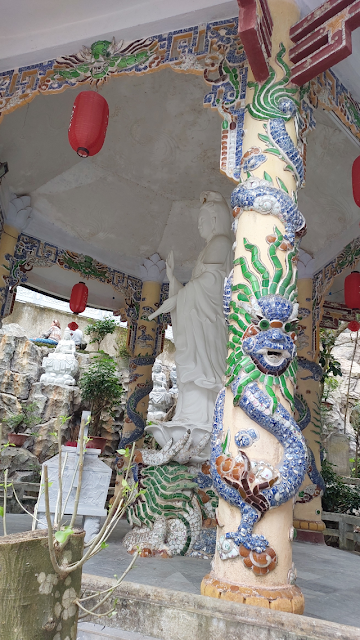Also known as the Non-Nuoc pagoda, Linh Ung pagoda is the first place one sees if coming up by gate number 2.
It is one of the holiest and the oldest pagoda in Da Nang. It is situated in Ha Thai which has the lowest peak in Thuy Son. We climbed up the elevator so visited the place while going down.
History:
Overlooking
the Non-Nuoc beach, this pagoda built in 1825 was named "Ngu Che Ung
Chan Tu". It was renamed in 1841 to Linh Ung Pagoda. Since, it overlooks Non-Nuoc beach, it is also called Non-Nuoc pagoda
Linh Ung means "wishes answered miraculously".
Special feature of this pagoda:
All
the names and decorations in this pagoda are made from small broken
pieces of porcelain. Look at them closely. Even the Guanyin pavilion is
decorated this way.There are two ways you can reach this pagoda: one is climb from gate number 2 and the other coming down from Van Thong cave.
Entrance gate when approaching from gate 2:
The entrance gate to pagoda is equally impressive.
dragon on side of steps
Entrance when coming from Van Thong cave:
Passing under the gate of Heaven and taking the path down is another way of reaching this pagoda.
coming down the stairs from Van Thong cave
Here, if one decides to go to Xa Loi tower or go down elevator, then you take a right turn. Turn left for Linh Ung pagoda.
entrance guarded by lions
name of pagoda at entrance
marble incense burner
Main Sanctuary:
The main sanctuary is not very big. There are three images in front and three Buddhas are worshiped here.
The main sanctuary is not very big. There are three images in front and three Buddhas are worshiped here.
The three Buddhas worshiped here are: Thich Ca Mau Ni (Sakhyamuni Buddha) in the center, on the right is Avalokiteshwar Boddhisattva and on the left is Kshitigarbha Boddhisattva.
Thich Ca Mau Ni (Sakhyamuni Buddha or Siddhartha Gautam), Buddha of the Present
Avalokiteswara Bodhisattava (Goddess of Mercy)
Kshitigarbha Boddhisattva
temple guardians outside the shrine
pillars outside the shrine decorated with porcelain tiles and chips
coiled serpent around the pillar
seated lion
Temple guardians:
Dwarpala( dwara: door, pala: ) are guardians outside a temple or pagoda in Hinduism and Buddhism. They stand either in human form or demon form and are fierce looking.
Vajravira and Garbhavira stand outside the pagoda
In Tang Dynasty, guardians were derived from yaksha of Indian mythology. They are in white marble stand outside the pagoda.The fierce looking guardians have muscular bodies, glaring eyes, and have weapons in their hands. Their torsos are pulled inwards, showing good abs and hair tied in a top knot. Only their lower body is covered. Ribbons circle around their heads forming a sort of halo.
Garbhavira
Garbhavira in Sanskrit and Mật tích kim cương in Vietnamese stands on the right side of entrance. He is the guardian of the Garbhadhatu Mandala or the Mandala of the Womb World.
His mouth is open as if making a "ah" sound.
He holds a vajra or vajra pani (a diamond club or thunderbolt) in his right hand. His left hand is lowered with fingers outstretched.
Vajravira
Vajravira in Sanskrit and Na la diên kim cương standing on the right side of entrance is the guardian of the Vajradhatu Mandala, that is the Mandala of the Diamond World and symbolizes latent power.
His mouth is closed meaning the end of life.
In his left hand, he holds a vajra thunderbolt. His right hand is raised and fingers spread out.
Both these guardians together symbolize the cycle of birth and death. Humans are born with mouth open uttering the sound "ah" and die saying "hoo". They both together form the word Aum which means "The Absolute" in Sanskrit.
Pavilion of Guanyin, Goddess of Mercy:
Just beside the pagoda is a beautifully decorated pavilion.
Goddess of Mercy, Guanyin
Flight of small steps lead to the center of pavilion.
pair of lions guarding the entrance
the pavilion stand on four decorated columns
two ancient tombs behind the Guanyin pavilion
Monuments of Prince Tran Quang Khai's mother( Queen Ly Thai), and Ngoc Lan (King Minh Mang's younger sister)
Prince Tran Quang Khai was a politician, military leader and a member of royal family of Dai Viet during the Tran dynasty.
Beside the pagoda is another shrine of Buddha with 9 heads
Phra Kao Na (Buddha with nine heads)
In front of pagoda by the side of main entrance, sits a huge 10 meter image of Buddha
The image sits with his back to mountains.
In front of the pagoda is a place with views over the sea.
Before going down the stairs from gate number 2 or for those climbing up, is a 600 year banyan tree under which are beautiful stone dragons.
We went down the steps and proceeded to Am Phu caves.



















































